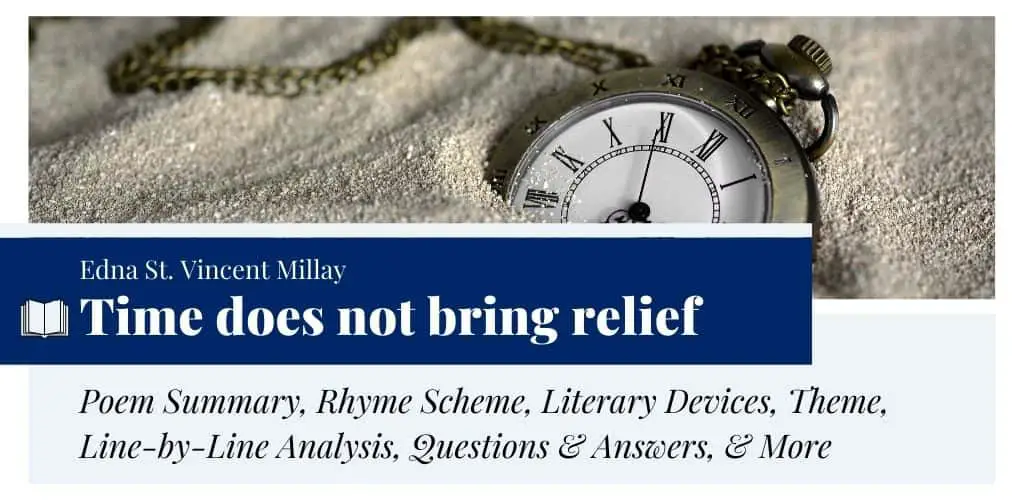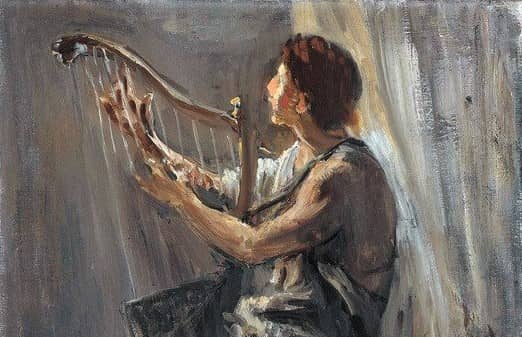Time does not bring relief; you all have lied by Edna St. Vincent Millay
“Time does not bring relief; you all have lied,” appearing second in the sequence entitled “Sonnets”, was one of the early sonnets of Edna St. Vincent Millay. The untitled piece was published in Millay’s first poetry collection, Renascence and Other Poems (1917). This sonnet is about a speaker seeking some sort of relief from the painstaking task of forgetting her loved one. No matter how hard she tries the memories still haunt her and if she finds a place without her lover’s trace, paradoxically it intensifies her remembrance. The heightened passion of these lines is unmatchable, showcasing the mastery of Millay’s sustained versification.
- Read the full sonnet “Time does not bring relief; you all have lied” below:
Time does not bring relief; you all have lied (Sonnet II) by Edna St. Vincent Millay Time does not bring relief; you all have lied Who told me time would ease me of my pain! I miss him in the weeping of the rain; I want him at the shrinking of the tide; The old snows melt from every mountain-side, And last year's leaves are smoke in every lane; But last year's bitter loving must remain Heaped on my heart, and my old thoughts abide! There are a hundred places where I fear To go,—so with his memory they brim! And entering with relief some quiet place Where never fell his foot or shone his face I say, "There is no memory of him here!" And so stand stricken, so remembering him! - from Renascence and Other Poems (1917)

Summary
The sonnet “Time does not bring relief; you all have lied” begins with a heated statement filled with the speaker’s agony and frustration: “Time does not bring relief,”—indeed, a paradoxical way of beginning a poem. According to the speaker, everyone lied to her about the fact that eventually, she would forget her loved one. In reality, she misses him when it rains and wants him badly when the tides shrink in summer.
Last year’s bitter snows melt as usual at every mountainside and the dried leaves are burned to ashes, yet there is no change in her heart. It still winters in her heart and the memories are heaped like snow.
There are several places where the speaker wants to go for a change. But she can’t, out of the fear of meeting him once again in her thoughts. Yet, when she finds a lonely, quiet place without a single trace of him, she stands “stricken” in his lover’s addled remembrance.
Form, Rhyme Scheme, & Meter
Form
“Time does not bring relief; you all have lied” (sonnet ii) is written using the Italian or Petrarchan sonnet form. It contains one octave (the first eight lines) and a sestet (the last six lines), separated into two sections in the earlier collections. Millay wrote this poem from a personal perspective using the first-person pronoun “I”. This incorporates a sense of subjectivity and injects intense emotions into the lines.
Rhyme Scheme
The rhyme scheme of the sonnet “Time does not bring relief; you all have lied” is ABBAABBA CDEECD. The octave perfectly follows the Petrarchan rhyming model while the sestet contains a slight variation. It is important to note how the poet uses the closed rhyming pattern (ABBA) to create an intricate sound scheme. Besides, the rhyming words resonate with the speaker’s mood, such as “pain” and “rain”.
Meter
This sonnet is composed in iambic pentameter, with each line consisting of five iambs. There are ten syllables per line and the stress falls on the second syllable of each foot, giving a sonorous outlet to the speaker’s passion. Let’s have a look at the intricacies of the metrical pattern through scansion:
Time does/ not bring/ re-lief;/ you all/ have lied
Who told/ me time/ would ease/ me of/ my pain!
I miss/ him in/ the weep/-ing of/ the rain;
I want/ him at/ the shrink/-ing of/ the tide;
The old/ snows melt/ from eve/-ry moun/-tain-side,
And last/ year’s leaves/ are smoke/ in eve/-ry lane;
But last/ year’s bit/-ter lov/-ing must/ re-main
Heaped on/ my heart,/ and my/ old thoughts/ a-bide!
There are/ a hun/-dred pla/-ces where/ I fear
To go,/—so with/ his me/-mo-ry/ they brim!
And en/-ter-ing/ with re/-lief some/ quiet place
Where ne/-ver fell/ his foot/ or shone/ his face
I say,/ “There is/ no me/-m(o)ry of/ him here!”
And so/ stand strick/-en, so/ re-mem/-b(e)ring him!
Note how the first line begins with a trochaic foot or falling rhythm. Then the speaker catches the iambic or rising beat in each foot. In the last line of the octave, the same pattern is followed. The other metrical shifts occur in lines nine and thirteen.
Literary Devices & Figurative Language
Millay sprinkles a number of literary devices in “Time does not bring relief; you all have lied.” The most important ones are exemplified below:
Paradox
Millay exceptionally uses paradox at the beginning and end of the poem. The opening line reads, “Time does not bring relief” toppling the ideal belief that time does bring relief to an aching heart. However, the rule does not apply in the speaker’s case or anyone who suffers for the absence of someone too dear to lose.
In the concluding lines, the speaker cannot help but miss his loved one even in the place bearing no trace of him. It intensifies her pain to think there can be one such place where her lover does not exist.
Rhetorical Exclamation
Another important literary device in the poem is a rhetorical exclamation which Millay uses pretty liberally. The actual version of the poem contains this device in five instances while in the later edited version, there are only two instances of rhetorical exclamations. It undoubtedly lessens the intensity of the speaker’s feelings. For instance, the last line of the octave expresses the helplessness of the speaker; thus Millay ends the lines with an exclamation mark.
Anaphora
It occurs in lines 3-4:
I miss him in the weeping of the rain;
I want him at the shrinking of the tide;
By using this device, the poet internally connects the idea of missing someone.
Alliteration
The repetition of the similar sound at the beginning of neighboring words is present in the following phrases:
- “told me time”; “me of my” (line 2)
- “last year’s leaves” (line 6)
- “Heaped on my heart” (line 8)
- “fell his foot” (line 12)
- “him here” (line 13)
- “so stand stricken, so” (line 14)
In the last line, readers can understand how the alliteration of the “st” sound hinders and “stricken[s]” the pace.
Metaphor
- Millay uses a metaphor in the second line, where she compares “time” to a healer, having the ability to ease one of their pain.
- In the following line, she implicitly compares rain to “weeping”.
- In the last two lines of the octave, the feeling of love is compared to heaped snow or dried leaves.
- The sestet begins with a metaphor of physical places compared to memories.
Hyperbole
Millay’s persona uses several hyperbolic expressions, such as missing someone throughout the year. Alongside that, the phrase “a hundred places” contains hyperbole.
Repetition
In the octave, Millay uses repetition to connect the lines and create a contrast. For instance, the phrase “last year’s” in lines six and seven is used to present two contrasting situations. Similarly, in the sestet, the repetition of “memory” presents another contrast.
Line-by-Line Analysis & Explanation
Lines 1-4
Time does not bring relief; you all have lied
Who told me time would ease me of my pain!
I miss him in the weeping of the rain;
I want him at the shrinking of the tide;
While publishing the poem in Renascence and Other Poems, Millay did not give a title to this sonnet. It appears as the second sonnet of the sequence, based on the stock theme of sonnets, a lover’s desperation for her loved one’s absence. Particularly, this sonnet is best-known for its paradoxical beginning that creates a shocking effect on the attitude. The speaker’s world is not as flowery as the readers think. She lives in reality and thinks practically.
In the real world, the pain of heartbreak cannot be healed if the lost person is someone too dear to lose. People around also consoled her by saying time would ease her pain. Millay emphasizes the term “pain” in the phrase, “ease me of my pain”. She presents a picture of the “self” alongside the existing “pain”.
The use of anaphora in the next lines portrays how badly the speaker misses her lover. When it rains, she thinks nature weeps for her state. The “shrinking of the tide,” symbolizes the ebbing of her happiness. Through these lines, she describes how she misses him throughout the year. It is interesting to note the images. The poet only chooses those from the summer season, appropriate to the mood.
Lines 5-8
The old snows melt from every mountain-side,
And last year’s leaves are smoke in every lane;
But last year’s bitter loving must remain
Heaped on my heart, and my old thoughts abide!
In the last four lines of this stanza, the speaker draws readers’ attention to the melting of old snows from the mountainside during the end of winter or the early summer. There is another imagery of change or natural transition in the next line.
The speaker depicts how the previous year’s leaves, which have fallen this year, burned in every line. Millay refers to the effect (“smoke”) instead of the cause (“burning”). It is a use of metonymy. On top of that, the lessening of the pain is of much more importance than burning in it.
In the following lines, Millay creates contrast by repeating the phrase “last year’s”. She presents two scenarios. One is that of the burning of previous year’s leaves, a symbol of the elimination of past remnants. Another image is that of the old year’s memory that lies heaped in the speaker’s heart. The term “bitter” is not used to qualify the act of “loving”, but to highlight the speaker’s “bitter” feelings due to her loved one’s absence. Alongside that, her old memories still “abide” or reside in her heart. Thus, there is literally no possibility of forgetting him.
Lines 9-12
There are a hundred places where I fear
To go,—so with his memory they brim!
And entering with relief some quiet place
Where never fell his foot or shone his face
The volta of the sonnet “Time does not bring relief; you all have lied” occurs in these lines. In the octave, the speaker discusses how badly she misses her lover. Her tone reflects a sense of longing and helplessness. However, as the sestet begins, her tone changes. Now, she seeks a place where she is not reminded of him. Yet, she fears to linger in her memory lanes as there is no single memory not brimming with his lover’s sense. Somehow, she manages to find a “quiet place” within her mind, where his foot never fell nor his face shone. Through these lines, she refers to the memory without her lover in it.
Lines 13-14
I say, “There is no memory of him here!”
And so stand stricken, so remembering him!
The existence of such a “place” in her mind, makes her sadder than before. It is reflected in the rhetorical exclamation, “There is no memory of him here!” Paradoxically, instead of getting relaxed, she stands “stricken” (more distressed) with his remembrance. The place within her mind makes her more desperate and helpless. In this way, the cycle of longing does not end. This conclusion justifies the main argument of the sonnet, “Time does not bring relief.”
Theme
Millay’s sonnet “Time does not bring relief; you all have lied” explores the theme of missing one’s loved one, accompanied by the aching. The speaker of this sonnet describes how time fails to heal her pain. It is because she cannot help but remember and miss her loved one. The old thoughts do not let her free. While she tries to find a place without her lover’s trace, it intensifies her distress. His absence in her memory makes her more desperate. Thus, she starts thinking about him again. Apart from that, the sonnet also contains the theme of time, love, and memories.
Tone
Millay writes this sonnet from a subjective point of view. That’s why the tone of her poetic persona is emotional, sad, helpless, and distressing. The speaker describes how her lover’s memories still linger in her mind even though she tries to forget him. In the first stanza, the speaker describes how she misses him. Thus, the tone of this section sounds sad and helpless. In the second stanza, she finds a way out, but she returns to the same spot. For this reason, her tone reflects a sense of desperation and weariness.
Historical Context
The sonnet “Time does not bring relief; you all have lied” was published in Edna St. Vincent Millay’s first collection of poetry, Renascence and Other Poems in 1917. After graduating from Vassar College, Millay moved to New York City in 1917 to make a career as a poet and actress. She started sending her poems to different periodicals and magazines. Finally, Harper & Brothers agreed to publish her first book of poetry in the same year. According to critics, Millay’s early sonnets including those published in this collection reflect her poetic genius. Her later works could not match the passion and versification of these sonnets.
Questions & Answers
One of Edna St. Vincent Millay’s best-loved poems, “Time does not bring relief; you all have lied” explores the theme of intense longing for one’s loved one. This theme is accompanied by the speaker’s heartache caused by the lover’s absence. She talks about how badly she misses him throughout the year. When she tries to find a place without his trace, it paradoxically reminds her of him. The speaker of Millay’s “An Ancient Gesture” also goes through a similar phase.
The sonnet “Time does not bring relief; you all have lied” by Edna St. Vincent Millay means how it is difficult to forget one’s loved one, too dear to lose. It is literally impossible for a person to ease the pain of losing his or her loved one. The pain exists only the reaction changes with time. Thus, time does not bring relief to an aching heart. Millay presents a similar idea in her free-verse poem “Spring”.
The poem “Time does not bring relief” was first published in 1917 in Millay’s collection, Renascence and Other Poems. It was composed around the same year.
The rhyme scheme of the sonnet is ABBAABBA CDEECD. It follows the Petrarchan model.
The “smoke” is an implicit reference to the burning of last year’s leaves in every lane. It is an example of metonymy. Millay includes the effect in place of the cause.
In one of the speaker’s memories compared to a “quiet place,” her lover’s foot never fell nor his face shone. After reading the poem, readers come to know that such a memory intensifies her pain.
Similar Poems about Missing Someone
- “An Ancient Gesture” by Edna St. Vincent Millay — This poem alludes to Penelope’s suffering caused by Ulysses’ absence and particularly to the gesture of wiping her tears.
- “If you were coming in the Fall” by Emily Dickinson — The speaker of this poem describes how she is ready to wait for an eternity if she is sure of her lover’s return.
- “Grief Calls Us to the Things of This World” by Sherman Alexie — In this poem, the speaker expresses his anguish at the cyclical nature of suffering caused by a loved one’s death.
- “I wish I could remember that first day” by Christina Rossetti — This poem is all about a speaker’s remembrance of her first love.
Useful Resources
- Check out Rapture and Melancholy: The Diaries of Edna St. Vincent Millay — Explore some of Millay’s intimate, eloquent confessions and keen observations that provide the key to understanding her poetic journey from obscurity to world fame.
- About Edna St. Vincent Millay — Learn about the poet’s life and works.
- Poet Profile of Millay — Read more about the poet and explore some of her well-known works.






